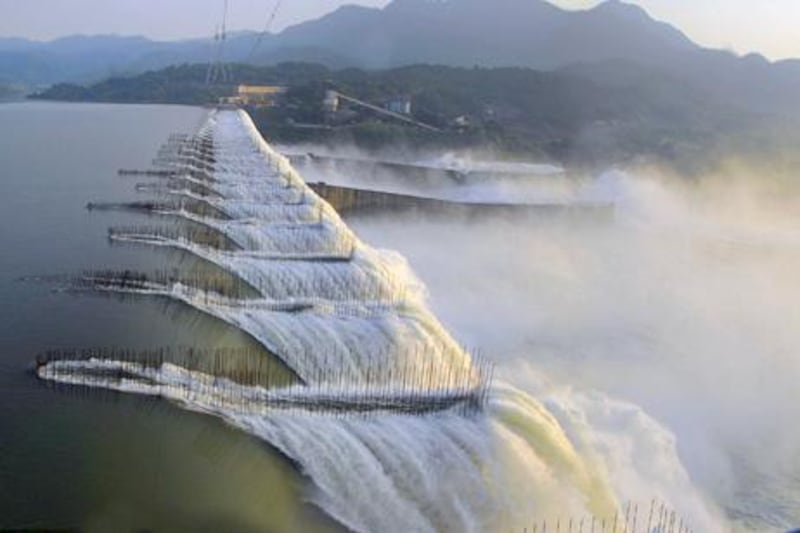BADWANI. INDIA // After decades of protest against India's controversial Narmada dam project, activists say as many as 200,000 villagers remain under constant threat of flooding and have yet to be compensated.
Dayal Solanki, a 16-year-old tribal villager from Bhadal in the central state of Madhya Pradesh, was only a young child when his home was first flooded by the rising Narmada River. The experience has coloured his entire life.
"Suddenly in the night the water came into the house and my family had to run up the hill," he said. "Our house was destroyed, our crops were destroyed, our livestock killed.
"We have been flooded three times since then, and we are always afraid it will come again. My family has been forced to move higher and higher into the hills. We have lost the plains that we had before where we could grow peanuts, oil seed and wheat. Now we can just grow a little corn."
Dayal's story is matched by thousands of other families in Madhya Pradesh, victims of rising river levels caused by the construction of hundreds of dams along the Narmada River. Heavy rains can lead to large-scale flooding, sometimes permanent.
The main source of their trouble is the giant Sardar Sarovar Dam, whose height has been increasing steadily since work started in 1979 and is due to reach 138 metres in the next few years.
The Save Narmada Movement (known by its Hindi acronym of NBA) was formed 25 years ago to fight the construction plans through non-violent means and demand compensation for the thousands of families forced to evacuate the area.
The NBA is often criticised for blocking much-needed development in drought-prone areas. The central government has claimed that for every person displaced by the project, 100 more will benefit from power generation and irrigation.
But for its supporters, the NBA has raised vital questions about the impact of industrial development on rural societies that strike at the heart of the challenges facing a rapidly modernising India.
"The NBA was able not only to build trust with tribal groups but also convince them of their right to protest against the state. In that sense, it has been extremely significant," said Meenakshi Ganguly, South Asia director for Human Rights Watch. "It was the first movement to stretch across communities and put academics alongside those directly affected. For the first time, it showed the middle classes that others are paying the price for their development."
While the states of Gujarat and Maharashtra are also affected by the Narmada dams project, the vast majority are upstream in Madhya Pradesh, one of India's poorest states. The NBA says that 38,000 families - around 200,000 people - are still living in submergence zones without any of the rehabilitation promised to them.
According to Supreme Court orders in 2000 and 2005, villagers are supposed to receive land from the government of equivalent quality and size at least six months before they come under threat of submergence from a dam.
"Twenty-five years ago, my land got submerged - I had 10 acres," said Ratan Bhai, a farmer from Sugat village. "I lost all my belongings and firewood. When the officials came, all they could see was water and they said no village had been there. I have been given no compensation."
That was 1985 - the same year the NBA was formed by Medha Patkar, a research student who soon abandoned her studies to take up activism full time. Through her much-publicised hunger strikes and sit-down protests, she has become the leading figure not just of opposition in the Narmada Valley but of grass-roots movements across the country, helping to unite them into the National Alliance of People's Movements.
Thousands of supporters travelled to the Narmada Valley this weekend to mark 25 years of the NBA with five days of rallies, speeches and entertainment in different locations around the valley.
In one rally in the small town of Dhadgaon, around 3,000 people from surrounding villages gathered to show their support. Fiery speeches were interspersed with protest songs and dance performances by children in traditional tribal dress.
"This is about celebrating the empowerment process that has taken place through everyone's joint efforts," said Ms Patkar. "The people here can be proud that they have sent a message to the government and to struggles across the country that we can remain polite and non-violent despite all the violence of the system."
Although the NBA effectively forced the World Bank to withdraw funding from the project in 1993, wider progress has been slow and limited. The dams are still being built and the NBA faces a constant battle to enforce minimum standards of rehabilitation.
The Narmada Valley Development Authority, a department of the Madhya Pradesh government, says their compensation package is "absolutely perfect" and complies with the court order.
"We have done everything required by the legal framework," said the authority's vice chairman OP Rawat. "We have offered land for land, but most people wanted money. If anyone has a grievance they can approach the court and we are obliged to comply."
A report by the Narmada Control Authority, the government agency tasked with ensuring compensation for affected families, claimed in 2008 that every family had been rehabilitated, but activists say this is a total distortion.
"Nobody has been offered proper cultivable land in Madhya Pradesh," said Sanjay Pariklo, a lawyer who represents the NBA in the Supreme Court. "The villagers turn down the land because it is no good, so they are offered cash. That was never a part of the court orders."
"We will not touch cash - that has no value to us. We want land for land," said Dayal. "The government tries to bribe us to leave the movement, but the movement has given us the power to struggle. We used to be scared of officials - when they came, we would run away. But now we are not scared."





